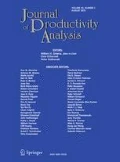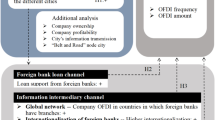Abstract
This study analyzes the relationship between R&D investment and the productivity of Korean R&D-engaged firms. An interdependent chain of equations including the propensity to invest, R&D investment and productivity are estimated in a multi-step procedure accounting for selectivity and simultaneity biases. Using Korean firm level panel data of listed firms from 1986 to 2002, we find four main empirical results. First, there is a two-way causal relationship between R&D investment and productivity for Korean listed firms. Second, Chaebol firms were associated with lower R&D growth as well as lower labor productivity growth in comparison to non-Chaebol firms. Third, there was a substantial reduction in growth rates both in R&D investment and labor productivity in 1997-1998, immediately following the Asian financial crisis. Fourth, considering the positive feedback effect from productivity growth to R&D growth, a decrease in R&D investment growth after the Asian financial crisis should have been harmful by further decreasing productivity growth.



Similar content being viewed by others
Notes
A noticeable increase in R&D output occurred during the 1990s. See Sakakibara and Cho (2002).
It can be implied that subsidies to R&D—and possibly other government policies as well—can affect economic growth rates in the long-term.
GNI per capita, Atlas method (current US$), World Development Indicators 2008, The World Bank.
According to the definition by the Korean Fair Trade Commission (KFTC), a chaebol or business group refers to a group of companies that holds more than 30% of its shares owned by some particular individual or by companies governed by those individuals. Since 1987, the KFTC has identified and listed business groups each year.
In constructing the dataset to be used, the listed firms between 1986 and 2002 were selected. However, the observations in 1986 were dropped in estimating the system of equations because transforming data into annual growth rate terms required creating lag variables. Hence, the length of period examined in the empirical analysis for the system of equations was 16 years.
Considering the significance and contributions of listed firms, the focus of this study is on listed manufacturing firms. A large proportion of these firms are engaged in R&D activities.
TFP is the weighted average ratio of total value added for all factors of production (labor and capital).
Due to limited space these results are not reported here but can be obtained from the authors upon request.
References
Aghion P, Howitt P (1992) A model of growth through creative destruction. Econometrica 60:323–351
Aghion P, Howitt P (2009) The economics of growth. The MIT Press, Massachusetts
Arrow KJ (1974) Economic welfare and the allocation of resources for invention. In: Arrow KJ (ed) Essays in the theory of risk bearing. North Holland, Amsterdam
Buxton W (1985) Talcott parsons and the capitalist nation-state. University of Toronto Press, Toronto
Cohen W, Klepper S (1996) A reprise of size and R&D. Econ J 106:925–951
Cohen WM, Levin RC (1989) Empirical studies of innovation and market structure. In: Schmalensee R, Willig RD (eds) Handbook of industrial organization, 2nd edn. Elsevier Science Publishers B.V, Amsterdam, pp 1060–1107
Crepon B, Duget E, Mairesse J (1998) Research, innovation, and productivity: an econometric analysis at the firm level. Econ Innov New Technol 7(2):115–158
Cuneo P, Mairesse J (1984) Productivity and R&D at the firm level in French manufacturing. In: Griliches Z (ed) R&D, patents, and productivity. University of Chicago Press, Chicago, IL, pp 21–54
Demsetz H (1969) Information and efficiency: another viewpoint. J Law Econ 12:1–22
Galbraith J (1957) American capitalism: the concept of countervailing power. M.E. Sharpe, White Plains, NY
Griliches Z (1979) Issues in assessing the contribution of research and development to productivity growth. Bell J Econ 10(1):92–116
Griliches Z (1985) Data and econometricians—the uneasy alliance. Am Econ Rev 75(2):196–200
Griliches Z (1986) Productivity, R&D and basic research at the firm level in the 1970s. Am Econ Rev 76(1):141–154
Griliches Z (1995) R&D and productivity: econometric results and measurement issues. In: Stoneman P (ed) Handbook of the economics of innovation and technological change. Basil Blackwell, Oxford, pp 52–89
Griliches Z, Mairesse J (1984) Productivity and R&D at the firm level. In: Griliches Z (ed) R&D, patents, and productivity. University of Chicago Press, Chicago, IL, pp 339–374
Grossman GM, Helpman E (1991a) Innovation and growth in the global economy. MIT Press, Cambridge, MA
Grossman GM, Helpman E (1991b) Quality ladders in the theory of growth. Rev Econ Stud 58:43–61
Hall BH (2002) The financing of research and development. Oxford Rev Econ Policy 18(1):35–51
Hall BH, Mairesse J (1995) Exploring the relationship between R&D and productivity in French manufacturing firms. J Econ 65:263–293
Heckman J (1976) The common structure of statistical model of truncation, sample selection and limited dependent variables and a simple estimator for such models. J Econ Soc Meas 5(4):475–492
Heckman J (1979) Sample selection bias as a specification error. Econometrica 47(1):153–161
Heshmati A (2003) Productivity growth, efficiency and outsourcing in manufacturing and service industries. J Econ Surv 17(1):79–112
Heshmati A (2009) A generalized knowledge production function. IFCAI J Ind Econ 6(1):7–39
Jones CI (1995) R&D-based models of economic growth. J Polit Econ 103(4):759–784
Kang JW, Heshmati A (2008) The Effects of credit guarantees on survival and performance of SMEs in Korea. Small Bus Econ 31(4):445–462
Katrak H (1989) Imported technologies and R&D in a newly industrializing country: the experience of Indian enterprises. J Dev Econ 31:123–139
Katrak H (1990) Imports of technology and the technological effort of Indian enterprises. World Dev 18:371–381
Kim H-S, Heshmati A, Aoun D (2006) Dynamics of capital structure: the case of Korean listed manufacturing companies. Asian Econ J 20(3):275–303
Kong M, Kim B (2000) R&D investment of firm and cash flows. Mid Small Sized Firm Stud 22(2):111–135 (In Korean)
Lall S (1983) Determinants of R&D in an LDC: the indian engineering Industry. Econ Lett 37(3):379–383
Lee BK (1995) The effects of private and public R&D and technology policy. Korea Econ Res Inst (Working Paper)
Lööf H, Heshmati A (2002) Knowledge capital and performance heterogeneity: a firm-level innovation study. Int J Production Econ 76:61–85
Lööf H, Heshmati A (2006) On the relationship between innovation and performance: a sensitivity analysis. Econ Innov New Technol 15(4/5):317–344
Medda G, Piga C, Siegel DS (2005) University R&D and firm productivity: evidence from Italy. J Technol Transf 30(1–2):199–205
Medda G, Piga C, Siegel DS (2006) Assessing the returns to collaborative research: firm-level evidence from Italy. Econ Innov New Technol 15(1):37–50
Ministry of Science and Technology (2002) Surveys on research and development activities for science and technology. Ministry of Science and Technology, Seoul. (In Korean)
Oh I, Lee JD, Heshmati A (2008) Total factor productivity in Korean manufacturing industries. Glob Econ Rev 37(1):23–50
Oh I, Heshmati A, Baek C, Lee JD (2009) Comparative analysis of firm dynamics by size: the Korean manufacturing. Jpn Econ Rev 60(4):512–538
Parisi M, Schiantarelli F, Sembenelli A (2006) Productivity, innovation creation and absorption, and R&D. Microevidence Italy Eur Econ Rev 50:2037–2061
Romer PM (1990) Endogenous technological change. J Polit Econ 98(5):102–271
Rosenberg N (1974) Science, invention, and economic growth. Econ J 84:90–108
Sakakibara M, Cho D-S (2002) Cooperative R&D in Japan and Korea: a comparison of industrial policy. Res Policy 31(5):673–692
Scherer FM (1965) Firm size, market structure, opportunity, and the output of patented inventions. Am Econ Rev 55:1097–1125
Seo J-H (2002) The structural change in R&D activities of Korean firms. Korea Development Instit Policy Res Series 2002(08) (In Korean)
Shin TY (2004) The contribution of R&D investment to economic growth. Sci Technol Policy Inst (Working Paper) (In Korean)
Williamson OE (1965) Innovation and market structure. J Polit Econ 73:67–73
Acknowledgments
The authors would like to thank the Associate Editor of the journal and an anonymous referee for their very useful comments and suggestions on two earlier versions of this paper.
Author information
Authors and Affiliations
Corresponding author
Appendix
Rights and permissions
About this article
Cite this article
Heshmati, A., Kim, H. The R&D and productivity relationship of Korean listed firms. J Prod Anal 36, 125–142 (2011). https://doi.org/10.1007/s11123-010-0206-y
Published:
Issue Date:
DOI: https://doi.org/10.1007/s11123-010-0206-y




